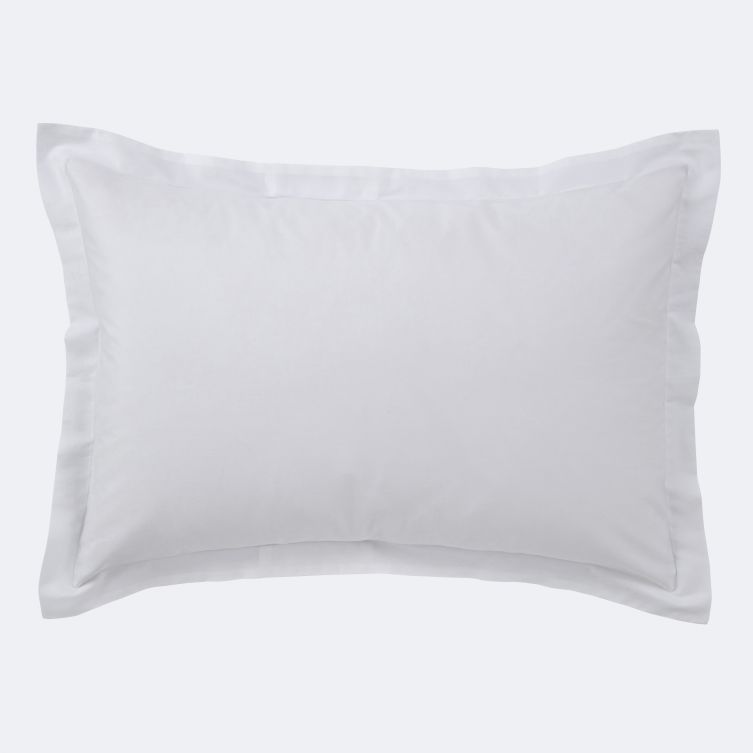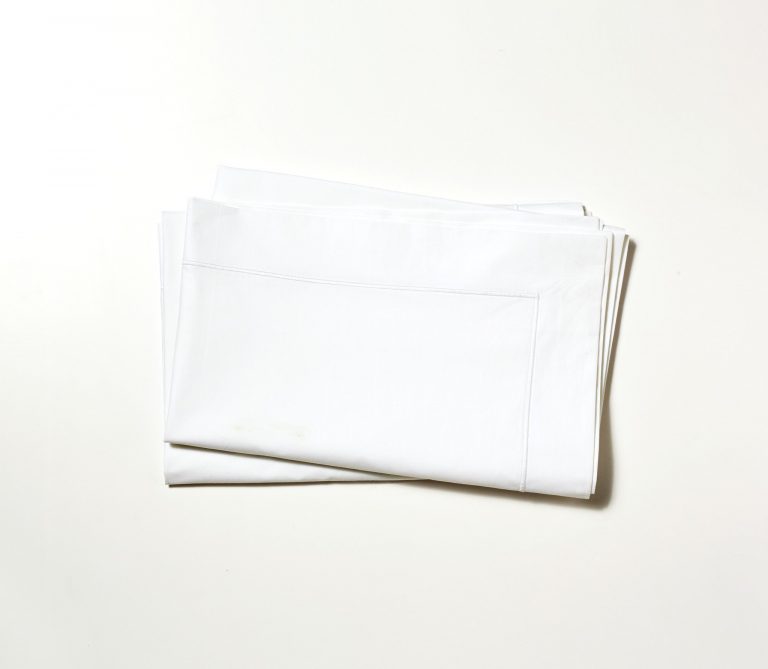Buying Guide – How to Choose the Best Pillow Sham
This guide will outline the purpose and types of pillow shams, along with common materials and color considerations.
The last section reviews some important points to consider when choosing the right shams to suit your needs.
What Are Pillow Shams?
Pillow shams are a specialized type of cover for pillows that can be used to add a decorative flourish to a room. Pillow shams and pillowcases may seem similar, but they are different in terms of form and function.
Pillowcases have a visible, open end on one side where you can slip the pillow into the case. Pillow shams often have an opening for the pillow on the back that is covered with overlapping fabric. This opening is not meant to be seen, so shams look as though they cover the whole pillow. Some pillow shams hug the shape of the pillow, while others may have a border of decorative fringe.
The other main difference between the two is that pillowcases are meant for sleeping on, while pillow shams are traditionally meant for decoration. The lines have blurred, as many pillow shams are made from materials that are also meant to be slept on. Regardless, the distinction remains as pillow shams today keep their unique shape and decorative elements.
As a decorative piece, pillow shams can be used to enhance a space in a variety of ways. Sham pillows can quickly add some needed color. For example, if your bedding is primarily black or brown, then a set of shams in a soft pink or blue could add a layer of contrast. A few extra sham pillows tucked behind your sleeping pillows can add a feeling of fullness to a previously bare bed.
A set of shams could also be matched to highlight decorative accents in a room. Light blue shams could draw out the light blue trim in a duvet cover. Some shams are even sold in sets with duvet covers or sheets to take the hassle out of matching colors and textures.
Pillow shams can also be used in rooms with a lot of similar features to help break up the monotony. For example, a set of lively, patterned shams can breathe life into a bedspread that is full of solid colors. A room full of neutral tones on the walls and bedding can be uplifted by using bright shams as pops of color. Mixing materials is another way to have shams stand out. A living room set of smooth leather furniture may benefit from a few very textured shams placed throughout.
Different Types of Pillow Shams
Shape and Size
Pillow shams typically come in three different sizes: Standard Sham (26” x 20”), King Sham (36” x 20”), and Euro Sham sizes (26” x 26”). Standard and King Shams are rectangular in shape and fit standard pillows meant for sleeping. King Shams are extra long and made to fit king-size pillows. Euro Sham pillows are square in shape and suit multiple purposes.
Pillow Sham Material
Pillow shams today come in the same variety of materials as sheets and other bedding. Here are some of the most common fabric types and important points to consider:
- Microfiber – Microfiber is a smooth, thin material woven from a blend of synthetics such as nylon and polyester. Microfiber tends to be durable, stain resistant, and available in a wide variety of colors and patterns.
- Linen – Linen is a luxurious fabric woven from strands of flax plant. Linen is thick and durable and tends to soften over time. Linen strikes a balance between coziness and breathability that makes it great for both hot and cold environments.
- Percale cotton – Percale cotton is cotton woven in a way that gives the material a crisp and smooth texture. Percale cotton is durable, breathable, and tends to stay cool.
- Sateen cotton – Sateen cotton is woven in a way that gives the material a silky smoothness. Sateen cotton has a distinctive look, but tends to be less durable and more likely to pill in the long run. It may be better to use sateen shams for more decorative purposes to reduce wear and tear.
Fit, Color and Pattern
Pillow shams typically come in the sizes of standard, king, and euro sham. Shams will shrink about as much as other bedding does, depending on the material. Cotton is generally the most shrinkable, although some types of cotton will be more shrink-resistant than others. As a way of countering shrinkage, some shams come in larger than average dimensions. Some companies will also pre-shrink their shams before sale.
Many shams intended for use in the bedroom come in calming, neutral colors with relaxing or elegant patterns. Shams meant for living spaces are more versatile, ranging from dark and simple to busy patterns full of neon. Keep in mind that these are general trends rather than hard and fast rules for decorating.
Sham colors will fade over time similarly to other types of bedding according to a few general rules:
- Dark colors and bright colors will show signs of fading the fastest
- Soft colors and neutrals appear to fade the slowest
- Synthetic fibers like microfiber tend to hold dyes longer than natural fabrics
- Shams that are exposed to direct sunlight fade faster
- Crisp whites may not fade as obviously, but there is risk of visible discoloration due to wear and tear
Finding the Right Pillow Shams
When trying to find the pillow sham that is right for you, it is important to consider your needs, desires, and intended aesthetic for a space. Here are some important points to consider:
Intended Use
Will your sham be used for sleeping, or perhaps lounging on a couch? If so, you will likely want to go for a sham with a durable material that can double as a pillowcase, such as linen or microfiber. If your shams are meant to be purely decorative, then the sham’s look will likely matter more than its material.
Surrounding Materials
When selecting a sham’s material for the bedroom, it is typically better to match the materials of your existing bedding.
When choosing sham material for a living space, it is important to consider the materials of the furniture in the space. For example, a smooth microfiber or sateen sham may look out of place on a textured corduroy couch. A linen sham may have a muted, rustic look that is well-suited to a leather couch or furniture with a strong wooden frame.
Using the Right Pillow Shape
Standard sham pillows are perfect for a bed, but may be an awkward fit for the ends of a couch. A single standard pillow can do well on a couch when matched with multiple euro pillows.
Euro sham pillows are versatile and can be used in both sleeping and living spaces. Euro pillows are great for couches in matching sets of two or varied sets of around five pillows.
Blending In or Standing Out
The visual effect a sham can have on a space can be stunning or soothing, depending on the room’s aesthetics. Blending and soothing are useful principles to follow for decorating a bedroom as too much activity may interfere with sleep.
Shams for living spaces can go either way. A drab, relatively featureless living room can benefit from shams that offer a strong point of contrast. For example, a set of bright green shams could help to break up the thickness of a room with darkly colored walls. A space with a lot going on in terms of color, patterns, or artwork may benefit from adding simple, solid color shams to anchor the energy of the room.
Pillow Sham Care and Maintenance
Proper care for your pillow shams will largely boil down to the sham’s material and the sham’s intended purpose. Pillow shams that are meant to double as pillow cases will need to be cleaned regularly if they are used for sleep. Many pillow shams that can be slept on are made out of machine-washable fabrics such as cotton or linen. Machine-washable shams are often washable on a cold water setting followed by a low tumble dry. Some pillow shams are made out of materials that must be dry-cleaned only, such as silk. Always follow the manufacturer’s instructions for proper care and washing of a sham.
Pillow shams that are not meant to double as pillow cases should not be slept on, as they may be easily soiled or worn by use. Retailers often indicate on the product’s information page whether or not a sham can be used as a pillow case.
Pillow shams of either type can be removed from the bed before sleep to help extend their life. Sham pillows can also be placed behind sleeping pillows to reduce direct wear and tear.
What Else Should You Consider When Buying Pillow Shams?
Ultimately, the main intended purpose of a pillow sham is to decorate a space. Here are some extra points to consider to help you fulfill your stylistic goals.
- Return and sleep trial policies – If you are uncertain about what look or feel you want from a sham, many companies offer trial periods for their shams with free exchanges. It may be worth going for a product with a flexible return policy so you can see how different colors and patterns actually look in a space.
- Purchasing sham sets – You may be able to save some time and money by purchasing bedding or pillow sets that include pillow shams. Shams in sets often have a well-blended overall look. The trade-off is that the look may not be as unique as if you had bought and matched the individual components yourself.
Envision a Plan for the Space
Outlining a plan for the space will help identify your needs in terms of pillow shams. Consider the colors, textures, and patterns already at play in the space. Are there any elements you would like to see more of or remove? What kind of energy do you want from the space? What role could an added sham play?



